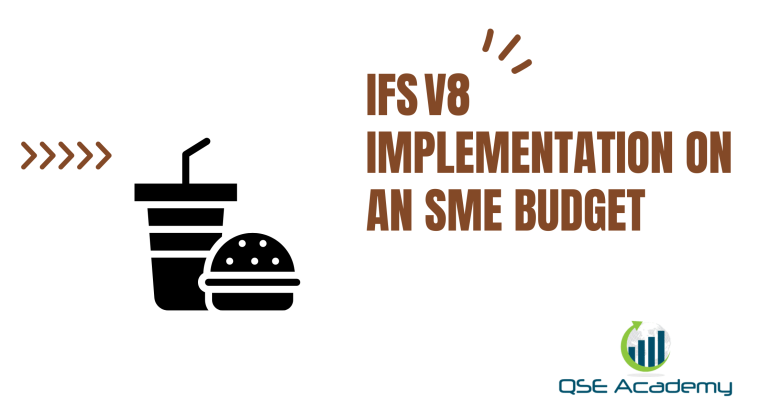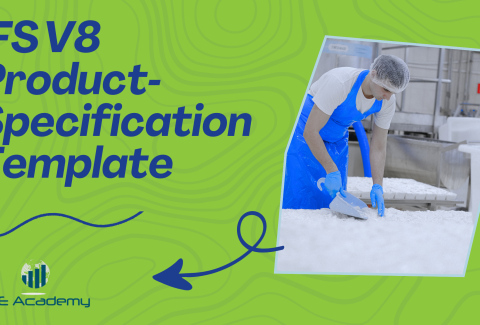IFS V8 Implementation on an SME Budget
Last Updated on November 18, 2025 by Melissa Lazaro
You Can Implement IFS V8 Without Overspending
When I guide SMEs through IFS Food V8 implementation, there’s usually a moment when someone asks, “Do we really need a huge budget to make this work?”
And the honest answer is no. You don’t need an expensive consulting package, brand-new equipment, or a full-blown digital platform to succeed. What you need is clarity: what matters most, what can wait, and where smart decisions replace expensive ones.
Smaller companies actually have an advantage — they move faster, communicate more naturally, and can implement change without layers of approval. With the right priorities and approach, SMEs can build a compliant, reliable, auditor-ready system without draining resources.
This guide walks through practical ways to implement IFS V8 step by step, while keeping cost and effort under control.
Prioritize Requirements That Matter Most — Focus Your Budget Where It Counts
Before you invest in tools, consultants, or upgrades, take a step back and assess what’s already working — and where the true gaps are. Not every requirement needs major changes.
Work through these questions:
- What’s already in place that meets IFS expectations?
- Which gaps affect safety and compliance directly?
- Which improvements must happen before certification — and which can wait?
- Where can existing processes simply be formalized or documented?
A focused gap analysis gives you direction — not a shopping list.
Pro Tip: Use a simple 3-tier priority model:
✔ Mandatory now
✔ Needed before audit
✔ Future improvement
This prevents spending money on “nice-to-have” projects that don’t move the audit needle.
 Leverage Existing People and Skills — Internal Capability First, External Support Only Where Needed
Leverage Existing People and Skills — Internal Capability First, External Support Only Where Needed
Many SMEs assume certification requires hiring external help for everything — documentation, validation, training, auditing. But in reality, your team already understands your process better than anyone.
Here’s a smarter approach:
- Assign an internal IFS coordinator
- Train supervisors and technical staff to own specific clauses
- Use micro-training to upskill your team gradually
- Only outsource technical expertise when absolutely necessary (e.g., HACCP review or validation support)
I’ve seen teams save tens of thousands simply by aligning responsibilities and empowering existing employees.
It also builds internal ownership — something money can’t buy.
Build a Lean Document System — Simple, Controlled, and Aligned With Reality
Some companies create hundreds of documents because they think more paperwork equals better compliance. In SMEs, that usually backfires — people stop using them, or documents become outdated quickly.
Instead, create a lean and usable documentation system:
- One Food-Safety and Quality Manual
- SOPs written in plain language matching real behavior
- Templates for records — not endless custom forms
- Clear version control and approval process
- Digital or printed — whichever the team will consistently use
If employees can’t follow a procedure on a busy day — it’s not practical enough.
Example: One small dairy cut recordkeeping time in half just by simplifying their forms — without changing a single control.
Upgrade Only What’s Necessary — Low-Cost Improvements Can Solve Big Gaps
IFS V8 may reveal equipment or structural issues — but not every gap requires a capital investment.
Before replacing anything, ask:
- Can the issue be addressed through cleaning changes?
- Can new monitoring, maintenance, or visual controls close the risk?
- Can temporary barriers, signage, or zoning adjustments achieve compliance?
Many SMEs meet requirements with practical, cost-effective solutions:
- Floor tape instead of walls
- Color-coded utensils instead of new equipment
- Storage rules instead of facility expansion
It’s about control, consistency, and risk logic — not aesthetics.
Use Smart, Affordable Tools — Technology Doesn’t Have to Be Expensive
Digital tools help, but you don’t need a fully customized QMS platform from day one.
Cost-friendly options include:
- Google Workspace or SharePoint for document control
- Trello, ClickUp, or Asana for project tracking
- QR-coded digital instructions instead of bulky binders
- Low-cost calibration and maintenance apps
- Free HACCP diagram or flowchart software
Start simple — scale later.
The goal is usability, not software complexity.
Prepare for the Audit Early — Because Proactive Planning Saves Money
Rushed preparation is where costs explode — emergency purchases, last-minute consulting hours, stress-driven fixes.
A structured timeline prevents that.
Key steps include:
- Quarterly internal audits
- Routine record reviews
- Mock interviews with operators
- Management review at least 3 months before the audit
- Evidence organization checklist
A well-planned audit phase means fewer surprises — and fewer unexpected expenses.
FAQs — What SMEs Ask Before Committing
Q1: Can we implement IFS V8 in phases?
Absolutely — as long as the system remains controlled and timelines are realistic.
Q2: Will auditors expect the same level of documentation as large factories?
No — they expect compliance and consistency, not corporate-level volume.
Q3: Do we need a consultant?
Only for gaps requiring expertise — not for the entire project.
Conclusion — Implementation Isn’t About Size or Budget, It’s About Strategy
IFS V8 implementation doesn’t require a massive budget — it requires intentional decisions, realistic planning, and systems your team can actually use.
When SMEs prioritize what matters, leverage internal knowledge, and use cost-effective tools, compliance becomes achievable — and sustainable.
Melissa Lavaro is a seasoned ISO consultant and an enthusiastic advocate for quality management standards. With a rich experience in conducting audits and providing consultancy services, Melissa specializes in helping organizations implement and adapt to ISO standards. Her passion for quality management is evident in her hands-on approach and deep understanding of the regulatory frameworks. Melissa’s expertise and energetic commitment make her a sought-after consultant, dedicated to elevating organizational compliance and performance through practical, insightful guidance.








